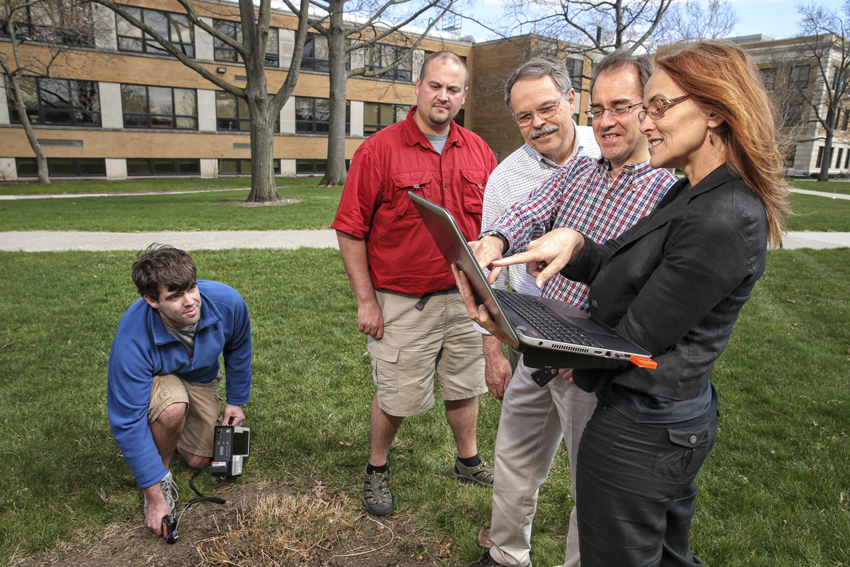BGSU adds master’s degree in Applied Geospatial Sciences

BOWLING GREEN, O.—“Anytime you ask the question ‘Where?,’ that’s GIS,” said Dr. Charles Onasch of Bowling Green State University. Whether it’s mapping tigers in India or tracking the distribution of natural gas or the production of manufacturing components, it’s necessary to know where and how what you’re looking for is distributed in space.
GIS, or Geographic Information Systems, is one of the tools BGSU students in a new master’s degree program in Applied Geospatial Sciences will learn to use, along with remote sensing and GPS, or Global Positioning System.
The program will have a broad focus on energy, although the skills it teaches may be applied to a wide array of disciplines, said Onasch, a professor of geology and director of the School of Earth, Environment and Society (SEES). The school comprises the departments of geography, geology, and environment and sustainability.
“In the area of energy, for example, you can study exploration, production, mitigation of environmental problems, policy and economics,” Onasch said. “You can take advantage of different tools depending on what you’re looking at.”
The new degree better represents the variety of concerns and disciplines of interested graduate students, said Dr. Joseph Frizado, vice provost for academic operations, who first offered courses in GIS in the geology department 25 years ago. “It’s a bigger tent,” he said, noting he’d taught such diverse students as a Ph.D. student in philosophy studying environmental ethics and sociology students studying demographics.
“The GPS tells you where something is located in space,” he explained, “while the GIS is taking information about things and attaching it to that location. It could be applied to, for example, an analysis of high schools BGSU might recruit students from. GPS can tell us how far away they are and where they’re located, but the GIS gives us such information as a description of their neighborhoods and income levels and the students’ academic profiles. It can be applied to such things as soil and air samples, crime levels or store locations.”
Diverse BGSU faculty represent the wide range of applications for geospatial skills. Geologist Dr. Andrew Kear, a specialist in energy policy, uses GIS in his research on fracking, while Dr. Robert Vincent, a professor emeritus of geology, used remote sensing in oil exploration but also for identification of developing algae blooms in community water supplies. BGSU geology alumnus Dr. Joseph Michalski applied the basic remote sensing skills he learned from Vincent in his research into the mineral makeup of the Mars landscape, leading to some surprising new discoveries about supervolcanoes.
Back on Earth, Dr. Andrew Gregory, an assistant professor in the SEES, is a spatial ecologist. He recently led environmental science students on a trip to India to assess biodiversity in the Amba Tiger Reserve as part of his conservation research, using GIS and remote sensing to locate and map his subjects.
On the human side, Dr. Kefa Otiso, an urban and economic geographer, uses it in his applied marketing geography course to answer questions about the distribution and characteristics of people who consume various products and to identify optimal sites for retail facilities, as well as to study the economic geography of Kenya.
“The most important tool of a geographer is the map,” Otiso said. “However, with GIS, we can create dynamic, electronic or digital maps that help us to answer important geographic questions in a fraction of the time it took us a decade ago. GIS is also good in evaluating ‘what if?’ scenarios, which is useful to planners in various economic sectors.
“Through GIS, we can make many types of databases mappable,” he said. “GIS is very powerful in that it can bring together many layers. It is capable of handling large data layers. City governments and urban planners can use it to create an overlay that contains everything from water lines to roads to access times to fire services.”
Demonstrating the spectrum of applications, Otiso noted that even farmers and planters can use it to know when to sow crops and apply fertilizers, while the military employs it in its smart weapons and drones.
In all these instances, data is tied to location, and location is important in understanding relationships, Onasch said. BGSU created the degree program in response to a growing need for professionals with the skills to answer questions in both the natural and social sciences.
“There’s a big demand for this type of degree lately,” Onasch said. The applied geospatial program will probably appeal most to professionals seeking to enhance their skills. The University hopes to expand it soon into a “four plus one” combined five-year bachelor’s and master’s degree program.
In the meantime, “We’re open for business. Students can begin to apply now,” he said.
Updated: 12/02/2017 12:51AM
